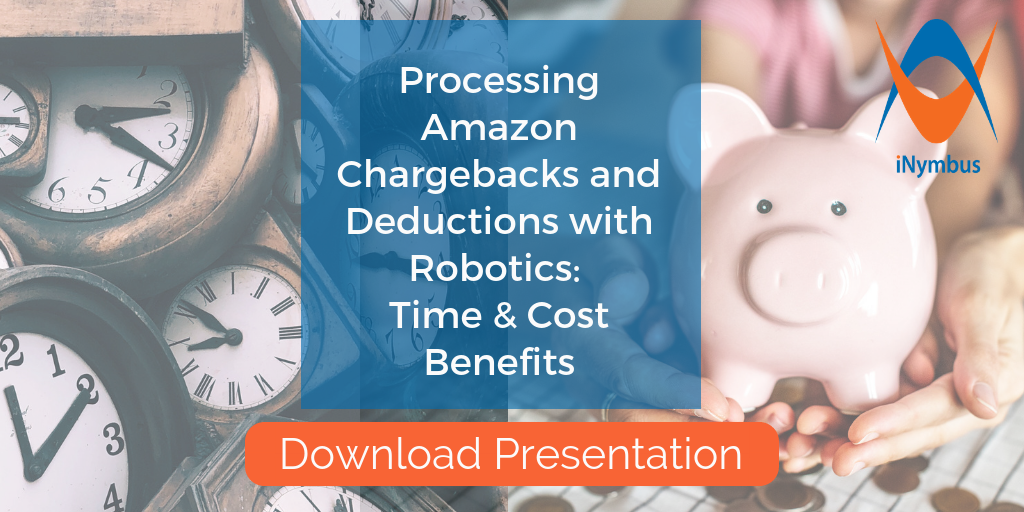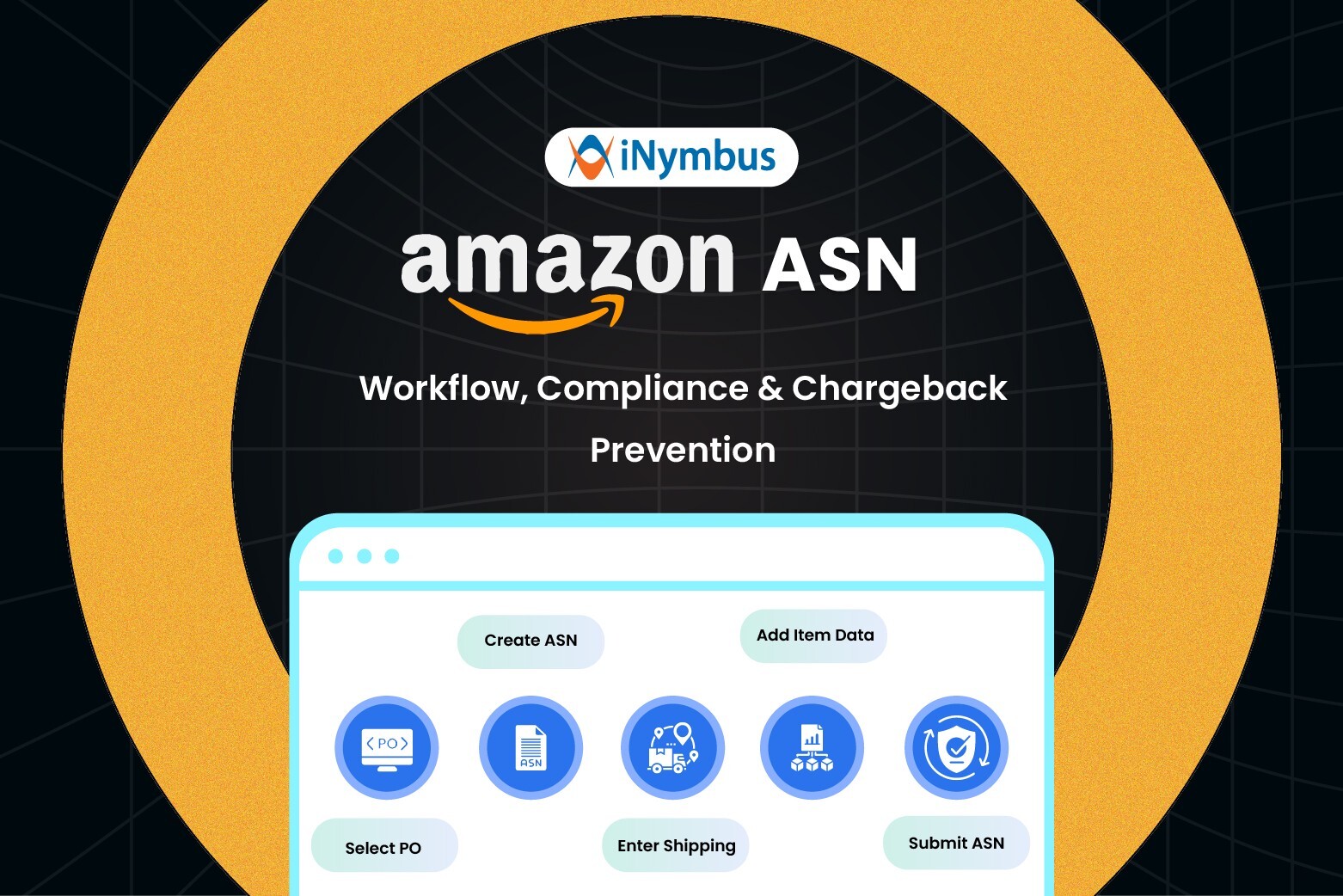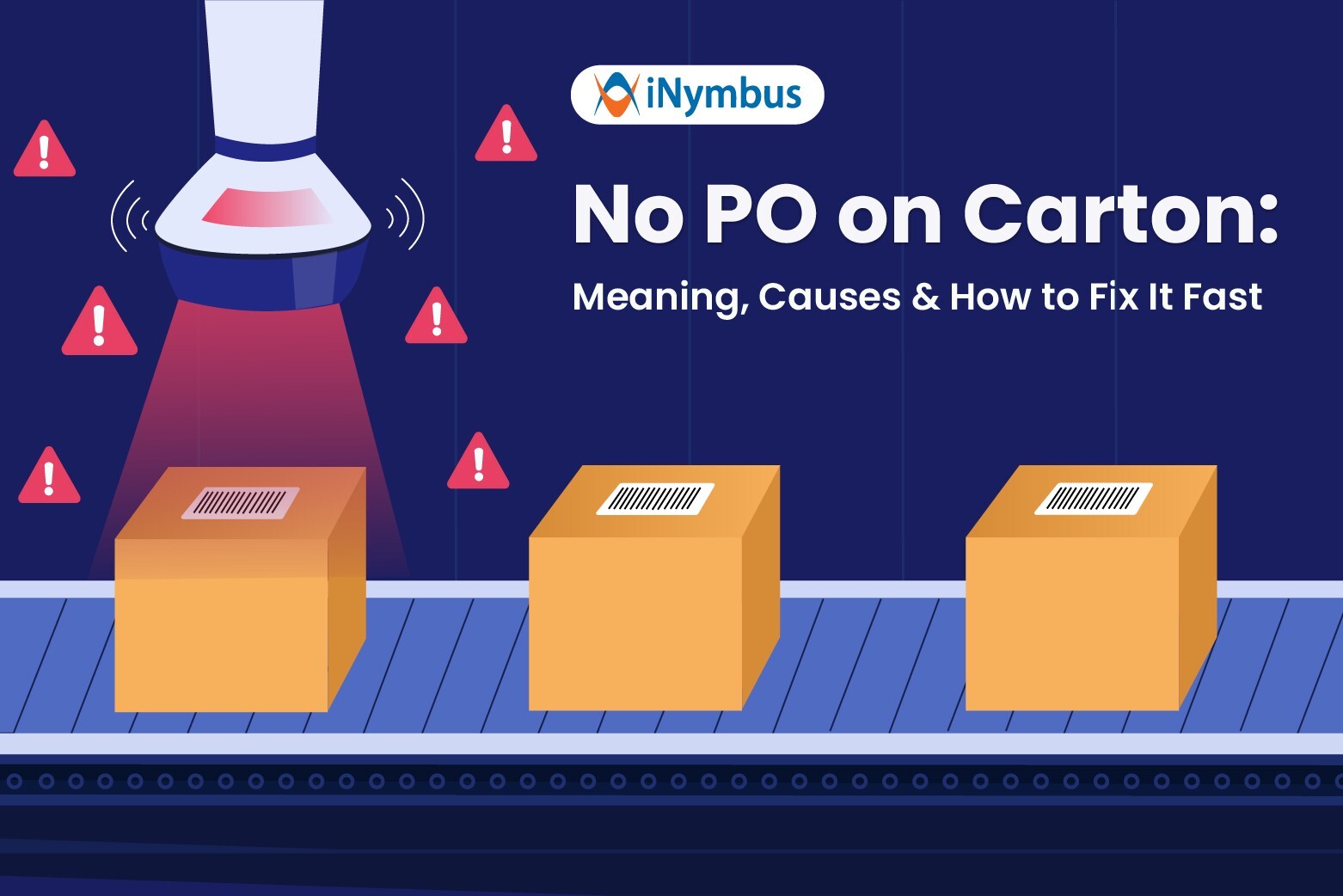Processing Amazon Chargebacks and Deductions with Robotics: Time and Cost Benefits
We recently participated in a webinar hosted by the Retail Value Chain Federation (RVCF), where we discussed the issues with Amazon chargebacks and deductions. We understand and feel your pain, and want to show you how using robotics to process and resolve chargebacks can save you time and money. In case you missed it, view our presentation from the webinar or read the transcript below.
Editor's Note: Though this blog post was originally posted in 2018 , the insights provided are still very relevant to this day.. Click here to learn more.
Kate Zablocky: Amazon spins deductions and chargebacks back at the buyer at an enormous rate and volume. The problem gets complicated as they have the ability to do that at the level of line item of invoice and PO’s. This combination of rate and volumes puts a tremendous amount of pressure on departments to resolve that. In this webinar, you will learn why robotics is a friend and coworker that takes away all the pressure of time and cost from the department unless the department go about their operations loosely and timely.
Presenting today's program is Rohit Patel, Credit and Collections Consultant at iNymbus. Rohit has extensive experience in the credit and collections arena with long tenures leading the credit and collections teams at Sony computer, Entertainment America, Warner Brothers, Home entertainment and ResMed.
At these companies, Rohit's expertise includes the development of strategic plans that led to improved financial operating result and successful global ERP implementation as well as other process and system enhancement that led to increased efficiencies. So without further ado, I'm pleased to turn the program over to Rohit.
Rohit Patel: Thank you, Kate. So again, the topic of discussion that Kate mentioned is Amazon chargebacks and deduction processing, via robots. And what does it really mean to the credits and collections departments? We are going to be talking about deductions today, and about technology in a credit and collections space, why you can't beat deductions without robots, and what you can do to get your own robots.
One of the questions I've always asked my team about chargebacks and deductions is, how does processing chargebacks and deductions make you feel? Often we have to get down to the root-cause to see what it does, but there is a psychological impact on the departments as a whole. One of the key ones is, "My staff are overwhelmed by the mountains of paperwork. We never seem to get ahead."
I remember at Warner Brothers when I started working there, we had almost two and half years worth of backlog. The team were doing settlements and reconciling on a quarterly or six months batch process. So the paperwork, it was overwhelming to the team.
Another response we see in is "I feel terrible that my team members have to do this kind of work". Somebody has to, we know it's repetitive and often it's the same work, over and over again. They often feel as if they're in a hamster wheel whose going round and round, but somebody's got to get this work done.
Another common response, "I dread the holidays because of the onslaught of Amazon, or replace Amazon with any retailer out there, chargebacks. I have to request a lot of overtime from my department." You may see this right after the holiday season or when you have a new release or product coming out, but there are dreaded times of year.
Last but not least, "I wince every time I order something from Amazon. Frankly, they make me a little angry." I do remember part of my team used to boycott going to Walmart because they were the biggest challenge we had. They would do all this work, and they would only get pennies on the dollar. So, it does have a psychological impact on them. I'm sure, these sound very familiar.
Sometimes chargebacks can simply get out of control if you have a disconnect in your supply chain. All the way from order to cash, if there are challenges there, those can pile up very quickly. Companies deal with this by hiring temps, and we'll talk about that as well.
“My staff hates this work.” It's repetitive and they don't feel like they’re adding value to the organization, and often are looking to move to other departments.
Now the same data needs to be entered into multiple systems so when a chargeback comes in if it comes in from a retailer that's not tech savvy, you may have to enter it into your ERP system, you may have to enter it into a deduction system, or an excel spreadsheet. Once you resolve it, you are going to have to enter it into a customer portal as well. The data is used multiple times, but if it's not fully automated, is entered into multiple systems.
Keeping up with the ever-changing retail portal slows things down more. I've seen where Amazon decided to change some of their technology and how your cursor would move across the screen, which people were having problems with. They may shift one data entry cell from the left-hand screen to the right-hand screen, or they may add additional fields. It's constantly updating. As they update their technology, you're having to keep with them and often that means retraining your team over and over again.
Once you have that huge pile you try to tackle it with resources, like hiring and training seasonal temps. But there is technology that's out there. How can you beat these retailers at their own game? It’s predominantly the major retailers, but also its FedEx and UPS. If there are issues with shipments you often have to go to FedEx or UPS to file a claim following for a lost shipment, and most of these companies have technology behind them.
A lot of these companies now are trying to discover buying patterns, but along the same line, that technology is being used on the backend to help them claw back money from distributors and wholesalers as it relates to vendor compliance or any type of chargebacks. They often will make you sign the vendor manual, which include clauses that have the ability to claw back a lot of that money from you.
In the world of chargebacks, companies like Amazon have more tech strategy, time and money than you will ever have. They're strategically ready to target whatever is going to be best for them and what is going to save them as much money as possible.
So how are robots used in processing chargebacks? A chargeback and deductions robot exists to solve only one problem. What the robot will do is, it will dispute retailer and shipper deductions and chargebacks at lightning speed. What I mean by lightning speed is that when a deduction is created, robots can actually identify when they are credit, what type of deductions they are, if it's a shortage deduction, and go ahead and pull the PO for you automatically.
It can go ahead and compare signatures and if the number of boxes are correct and there's a signature, it can automatically dispute that in a vendor portal. That process that I just described can be used for anything. It can be used for return shortages, it can be used for pricing. It's just gathering that information from other places and typically that's what one of your staff members would do, but robots are now designed to go ahead and do that. So your robots can actually be competing with the likes of Amazon and keeping pace with their deductions.
I've actually lived through this pain, through different companies I’ve been with. In the early 2000s, the technology was not there. At Warner Brothers, I had over a 100 staff and then seasonally we would hire almost 50 temps for the first quarter of a calendar year just to keep up with the deductions.
Along the way we put a software in there to manage the deductions, so they were all in one central area, so that the team could work with them easier. We added workflow to that process and we also added outsourcing. And a lot of companies use a combo of everything, but robots is something that's new, that not a lot of companies have discovered yet.
I realized some years back that chargebacks and deductions were unbeatable. My motto for my team was, "Stop the bleeding,” because of the volumes of deductions and the people that we had to work with, it took a long time to figure out how to go back up the supply chain.
Retailers and shippers, due to their size and technology investment, will always outpace suppliers. So they're going to continue to deduct more and more. They have the ability to go after pennies, and don't think for a minute that you have an accounts payables person that's actually writing up a chargebacks for a penny. It's robots that are doing this.
Technology is not just a bigger stick. It's a totally different way of dealing with deductions and chargebacks. Robots will allow you to fight fire with fire and bring your chargeback deductions to zero, and keep them there consistently. I've seen that happen where the chargebacks are coming in, and within 24 hours they're bring disputed and resolved. If you can't beat them, arrange to have them beaten.
What happens if there aren't any chargebacks to process? Change in any format is definitely scary. I’m sure you seen what happens when it's time for a company to be more profitable, it's always about shareholder value. You don't want to layoff your friends but more and more companies have been asked to do more with less.
But here's what really happens. There is a great case study from D&H Distributing, and I'll read some quotes directly from them. "It's actually the abilities that we haven't had to add staff, we reallocated capable folks into more valuable and more enduring paths, like the root cause analysis to help reduce the deductions." Another quote, "All we were doing was plugging holes, now robots plug them automatically. It gives our staff the ability to figure out where those holes are coming from in the first place."
With this technology, you can reallocate capable folks to add more value staff. They were able to go back, perform a root-cause analysis and help reduce the deductions in the first place, not just deal with the volume of deductions. That's where the value add comes in from your organization, and you're adding more value to the individuals on your team. They’re not only doing repetitive work, they're now challenging themselves, bringing that knowledge they have as it relates to dealing with deductions and staff, and plugging those holes again. So now they can “stop the bleeding,” go back upstream, meet with the departments, meet with sales, meet with management, and so forth, because the robots will be doing deduction processing for them.
Can you keep your expenses flat? Another few quotes, "We can reallocate headcount now, and use the staff in other areas that need attention outside of this world". "As we grow, we don't have to add bodies. We can make it work for us." Every penny that the robots are collecting for you, is money back to the company's bottom line. As the volumes of deductions grow and chargebacks grow, the robots automatically work faster and at the pace of the chargebacks coming in. Roots don't take lunch breaks, they don't take vacations, they don't sleep. So whatever you ask them to work, they will continue to work.
This also can allow you to go into new markets. Another quote from D&H, "It allows us to engage in customer distribution that we generally try to shy away from, because they are known for being troublesome. Particularly in the segment of grocery and drug stores, that are incredibly difficult to deal with. When we have this kind of tool in our arsenal, that allows us to engage in a different customer." Now they can focus in on new customers that they want to distribute for.
One more quote. "Not so fast Amazon. We've got our own little robot army here and we are going to fight you every step of the way." Like I've mentioned, you have to fight fire with fire or in this case fight technology with technology.
D&H says that they have up to three people who are adding value now. They are not processing chargebacks and deductions, so they've repurposed those heads. That's equivalent to about 6,000 man hours doing something else besides pushing paper or making copies, entering data, etc. They are far from done and looking at this technology and how they can use it in different areas as well.
Your department can transform to a strategic engine powering the company to go forward, rather than just being a perceived expense drain. There's always credit and collections, we have to have them as a necessary evil. The good news is you can turn it into a profit center and you can go back upstream, and focus on the root-cause problems, and add more value to your team and their day to day lives.
Let’s talk about numbers. A similar case study related to advantages of robotic automation processing looked at the time it takes to organize and file a claim. This varies, but they found it to be anywhere from three to six months. This is a huge backlog. The robots can pretty much do it within 24 hours, if not in the same day.
We've noticed that on the cash flow side as well, the cash is coming in much quicker versus three or six months later, when you're getting to filing those claims.
There have been instances where Amazon and Walmart are paying back within weeks of a chargeback. We know they have robots on their side too, so if you are disputing a chargeback, it’s not a person who is going to manually receive it on the retailer side. Therefore if it meets specific thresholds, then the retailer robots will automatically go ahead and pay those back for you.
Robots are constantly making sure that the data is entered in not only a timely manner, but accurately. That information comes from your systems or the retailer portal system, and so the training here is pretty much zero in the sense that if a retailer moves info from one corner to the other corner of the screen, the robots will figure that out automatically, and you don't have to manually train your teams over and over again.
How can you be part of this transformation? You should definitely look to schedule a demo for robotic process solutions. I mentioned solutions because there are companies that are out there that say that there are solutions to make sure that you find the right one for you, right? So definitely get a demo to see their capabilities are doing.
You’ll want to make sure that they are able to do robotic integration points and recommend a roadmap. Once you've got the demo ask, is this vendor capable of integrating with the Amazon's of the world, or whoever it may be. Then make sure there’s onboarding and training.
You got to have subject matter experts in these areas. Implementation experts to walk you through every step of the way and typically these are SaaS solutions. As a SaaS solution, they're going to take care of all of the updates for you, so that there should be little to no training on that side. Every day you have to put out fires, right? But you don't have to let urgent issues and fragmentation dominate your strategic vision.
If a company has a vision to put in robotics solutions not only in the deductions space but in other areas, and if it is a strategic vision for your department or the company as a whole, take this first step and actually just make sure that you do get a demo.
But what about IT? Your IT group may be big, they’re tough and fight any new technology or project and vendors. They have a million projects that they are doing, SAP upgrade, their onboarding EDI customer. They're doing all kinds of things for you, and sometimes they may claim to have some of these robotic technology as well.
Earlier this year, in the CIO magazine there was a quote. "Software that automates basic tasks is catching hold in large enterprises, where CIOs are seeking to inject greater efficiency into business processes. Again called Robotic Process Automation (RPA). Now the technology enables IT departments to use a piece of software, called a "robot" to perform routine tasks." It's real, it's out there. The Wall Street Journal, constantly uses robotic technology, so definitely the IT organizations are not scared of it, they actually do embrace this because this is the next step for them also. Don't be afraid of technology because it will free up your time to deal with the root-cause issues that are truly hurting your department.
iNymbus is one of the companies that Kate mentioned I consult with, and I’ll share the 10 reasons why:
- They have first person knowledge in the credit and collections space.
- Cloud-based solution scales with you, so no growing challenges. As more deductions come in, the robots will do that work for you.
- Robot building capabilities in-house. It's in there, they know it, they've done it, they've proven themselves.
- Artificial intelligence capabilities in-house as well. Everyone talks about AI but a lot of people are scared about using artificial intelligence. In the right space, it can be very powerful.
- Processes which keep us up with shipper and retailer portals and pivot quickly. Any changes to a portal, a SaaS solution should be able to do that automatically.
- Systems architect is best in class. iNymbus spent a couple of years developing the technology and really getting a process down to its basic core three to four steps. So the architecture built is in there.
- Implementation speed is weeks and not months. It is a SaaS solution and there is no need for an IT organization to maintain this solution. It's up to the SaaS provider to do that for you. There's IT involvement as it relates to accessing data and how the feeds go back and forth, but the implementation is as quickly as four weeks.
- Pricing is a Saas model.
- Customer has a direct line into iNymbus for issues. You can call directly and figure out what the problem is, and they are able to fix it. The good news is that not a lot of calls come in and once it's up and running, the robots are doing the work. It's only when there's a process change that people need to get involved. Typically, systems go up and down, but with this kind of solution, there’s not a lot of back and forth.
- No cost trial. Use the service for 30 days, prior to making the first payment. If you like it you can buy it, if not, no harm no foul.
iNymbus DeductionsXchange robots dispute. The robots are right there, ready for you. I will turn it over to Kate to open up for any questions that people may have.
Zablocky: Thank you, Rohit for all your insights and techniques. The first question that I have here is, can companies buy robotics process automation tools and do it themselves?
Patel: Yes. There are solutions out there that you can go ahead and buy if you Google it. But the challenge with that is the knowledge isn't there. You can go ahead and buy them but you would have to design each and everyone. You'd have to get IT involved to understand what their software can do. It's not as easy and plug and play to do that.
Zablocky: What are any security issues with robot assessing company data?
Patel: So far we've not seen any. Now it all depends upon your internet policy and your security policy within the companies that they have. Often there's pushes that go forward or there are secure FTP sites where this data can be stored, but the robots are basically repeating work that your team would do. If your team would have had access to this data and there was no security issue, same thing with the bots. If they have access to the same data there are no issues because they are entering customer portals, or they're entering your systems that are all secure and on either FTP sites or internet sites that are asking for security questions and so forth, there’s not an issue there.
Zablocky: Do retailers block robots from accessing their sites?
Patel: We've not seen that happen. Now retailers are becoming smarter and they'll try to deter robots from doing things, but we found out most companies, a robot is just another mechanism for you to access the portal and enter that information. So no, we have not seen many issues as it relates to accessing retailer portals.
Zablocky: How does AI come into play with robotics process automation?
Patel: So AI is again, artificial intelligence that works on gathering data. Where the robots are constantly doing repetitive work, all that data can be stored in a system. AI will come in and look to see if there are any specific patterns, whether it's signatures that it's looking for or the weight analysis, etc. So artificial intelligence is basically coming as the next step of robotic process automation. Once the robots are there, the data's in there, and artificial intelligence will come in and look to see how it can help with root cause analysis potentially.
Zablocky: Great. Well, thank you for all of the wonderful questions. Unfortunately, we are now out of time. A link to the on-demand version of this program will be available. On behalf of everyone in RVCF, we'd like to thank you for attending today's seminar. For those of you who have further questions about the material covered in today's presentation or whose questions were not addressed in the Q&A portion, please feel free to contact iNymbus directly.
Please note that iNymbus will be presenting at the RVCF Fall Conference so be sure to attend, introduce yourselves and ask questions. Thank you and have a great day.





